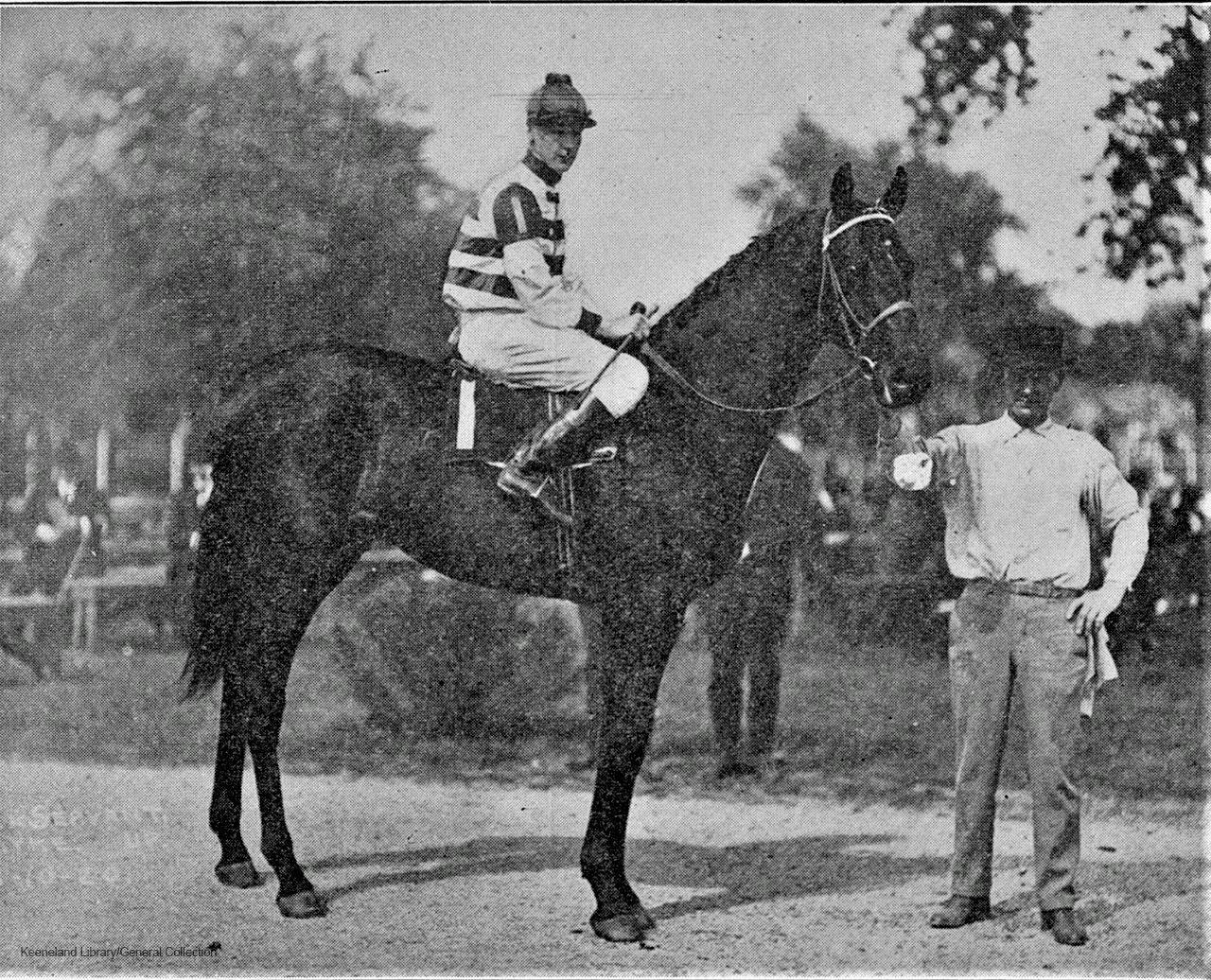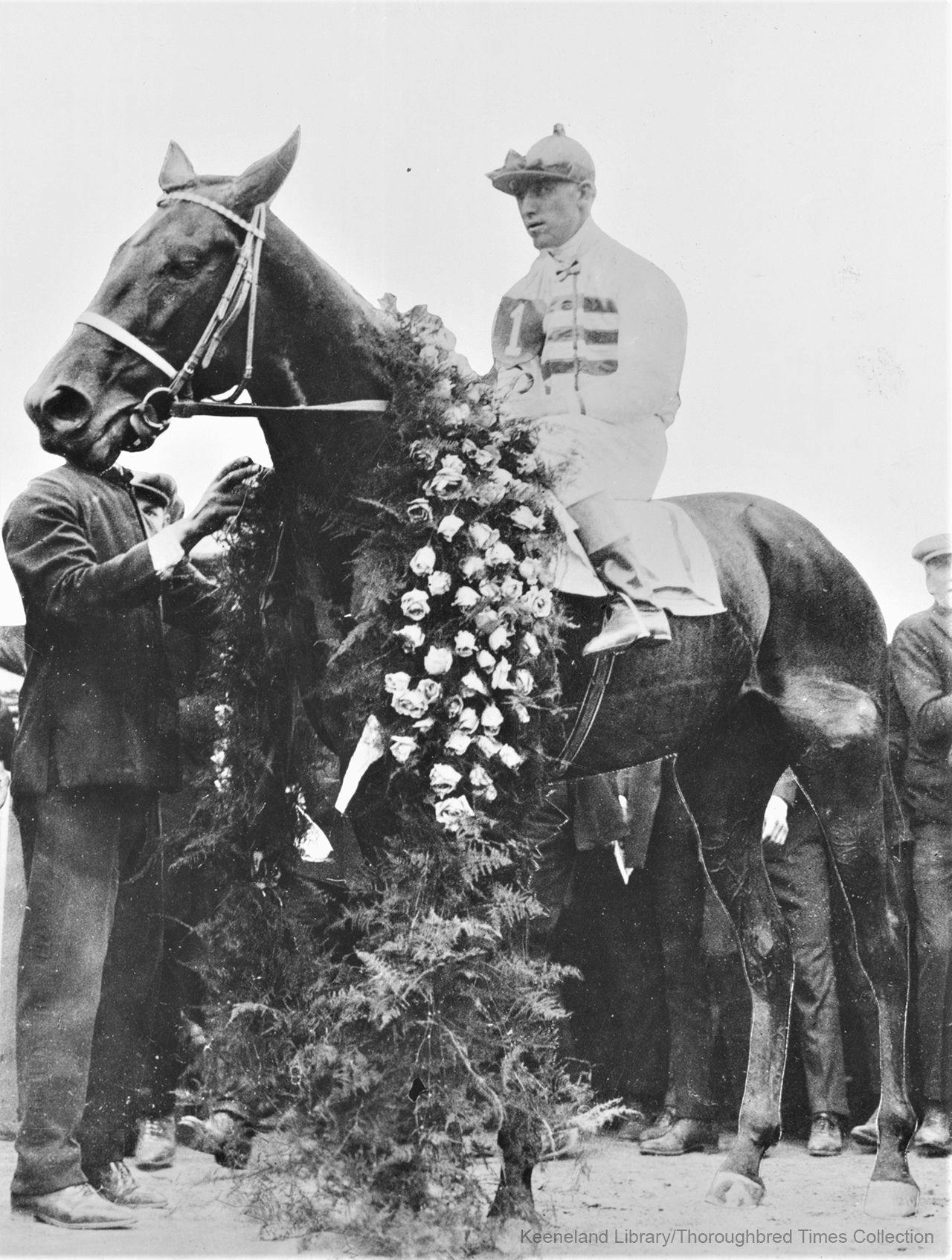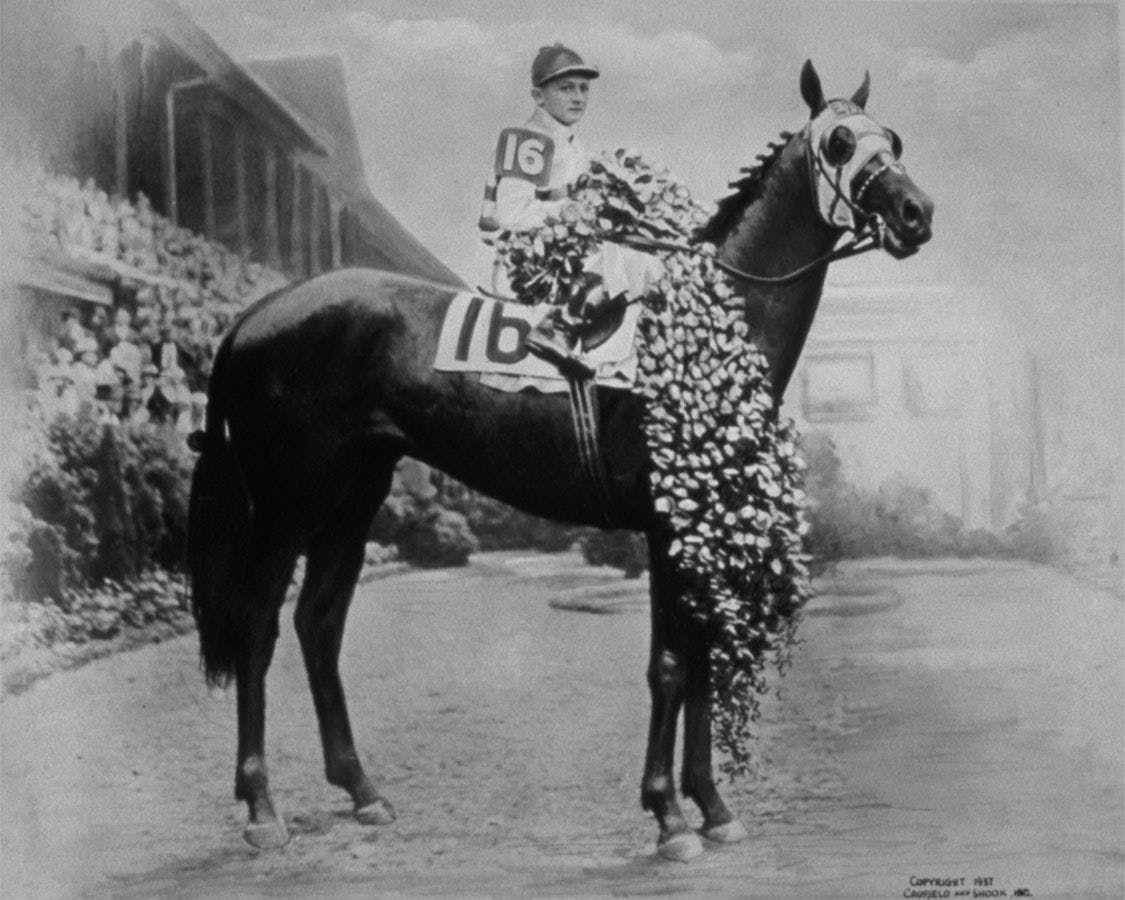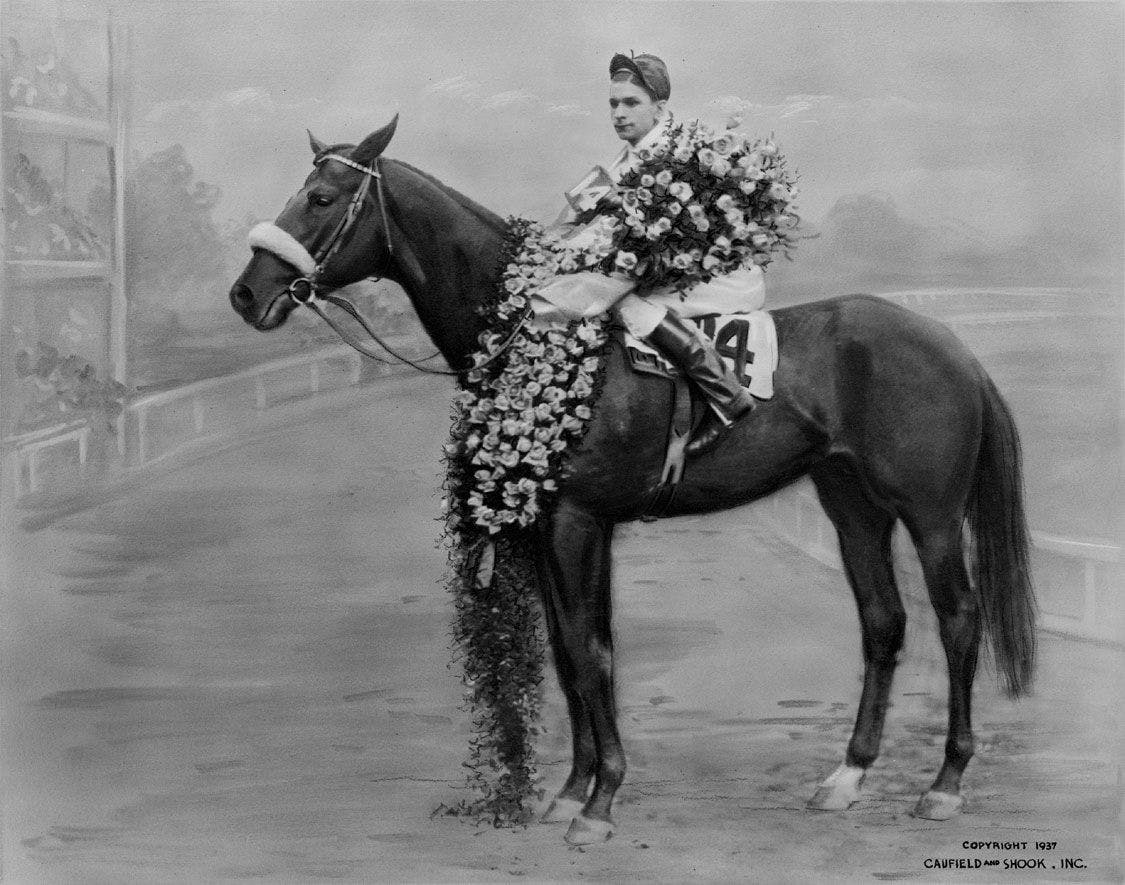One Hundred Years Ago, Colonel Bradley Goes for the One-Two

Colonel E R Bradley, H J Thompson and Jockey Albert M Johnson (Photo courtesy of the Keeneland Library/Cook Collection)
A century ago, the Kentucky Derby was blossoming into the Run for the Roses, America’s most famous horse race. Names now iconic in Derby history contributed to its growing popularity, these humans and horses synonymous with cascading blankets of roses and icy cups of mint juleps: Regret and Exterminator, Harry Payne Whitney and Colonel Matt Winn. In the 1920s and 1930s, another Kentucky colonel added his name to that list, Edward Riley Bradley.
A self-made man who built his fortune from games of chance, Bradley made his Idle Hour Farm into a dominant breeding and racing stable in the first half of the 20th century. Between 1920 and 1945, Idle Hour’s white with green stripes would be a common sight on Derby Day, his four winners second only to Calumet Farm’s eight. In 1921, the gambler turned sportsman visited the winner’s circle for the first time, but the horse draped in the roses was not the one that Bradley wanted to win.
A century ago, the wrong horse in the right silks won the Kentucky Derby in a close finish and put the gambler turned sportsman Colonel E.R. Bradley on the path to racing immortality.

Black Toney (Photo courtesy of Keeneland Library/Thoroughbred Times Collection)
Starting Small
The son of an Irish immigrant father and an American mother, Edward Riley Bradley was born on December 12, 1859, in Johnstown, Pennsylvania. He quit school at age 13 to work in a steel mill, but, within a year, young Edward found that life was not for him and took off west in search of opportunity. Bradley wandered through the West, purportedly working as a cowboy, a gold miner, and a scout for the U.S. Cavalry. While some of these tales might be more fiction than fact, what is verifiable is Bradley’s choice to make the business of gambling his vocation.
Getting into the gambling business came from an a-ha moment at his expense: he had built up some success delivering supplies in New Mexico, but lost his freight wagon and team of mules in a card game. Bradley then honed his skills wagering on bush races and dealing poker and other card games. By the time his brother John joined him, Bradley had opened several gambling rooms and livery stables near New Mexico’s mining towns. The brothers then moved to El Paso, Texas, where they established a successful saloon and clubroom, before making their way north from Texas to Chicago. Along the way, E.R. worked as a bookmaker at racetracks in Arkansas, Tennessee, and Missouri. His time in St. Louis also netted him another milestone: a wife. He married Agnes Currie in 1894, and the couple settled in Chicago. In his new location, E.R. continued his vocation as a gambler, opening and investing in casinos and using his resources to buy hotels and clothing stores.

Black Gold and jockey J. D. Mooney (Photo courtesy of Keeneland Library/Thoroughbred Library)
In 1898, a lifetime of stress had compromised Bradley’s health enough that his doctor recommended finding a less demanding use of his time and energy. At the same time, Florida was becoming a destination for those seeking sunshine and sandy beaches. Bradley took this prescription in two directions: first, he moved to Florida, where he and brother John opened the Beach Club in Palm Springs, and then, he bought a racehorse named Friar John.
Going Big
Friar John was not E.R. Bradley’s first horse nor was the Beach Club the first of the gambling establishments that he ran, but both were harbingers of a new direction. The Bradley brothers had previously owned racehorses, but Friar John led Bradley to purchase Brigade, with whom Bradley won enough to buy a horse named Bad News. Named such because “bad news travels fast,” this gelding became his first stakes winner. With that victory, E.R. Bradley decided to invest even more in his racing interests, leasing Ash Grove Farm outside of Lexington in 1905.

Idle Hour Horse Farm sign (Photo courtesy of the Keeneland Library/Meadors Collection)
In 1902, Bradley nominated Red Hook to the Kentucky Derby, the first of several horses he would nominate over the next decade and a half. In 1910, Bradley fully committed to pursuing breeding and racing his own horses, purchasing Ash Grove and renaming it Idle Hour. E.R. also set his sights on winning the Kentucky Derby. Bradley studied pedigrees, investing in European broodmares like Padula and La Troienne, and stallions like Black Toney and North Star III.
In 1920, the green and white of Idle Hour made its debut in the Run for the Roses with a colt named By Golly. In a Derby most notable for the big red horse that was not there (Man o' War), By Golly finished seventh behind winner Paul Jones. The next year, though, Colonel Bradley and trainer Herbert Thompson entered two Idle Hour-breds, Black Servant and Behave Yourself. Like Commander J.K.L. Ross in 1919, Bradley had two horses worthy of wearing roses, but only one outcome he wanted to see.
Right Silks, Wrong Horse
Black Servant was Colonel Bradley’s favorite, his pedigree purely Idle Hour: his sire was Black Toney, the farm’s foundation stallion who would sire 1924 Kentucky Derby winner Black Gold, and his dam was Padula, an English mare with a modest pedigree. At two, Black Servant had won only twice, but, at three, he won his first two starts of the year, including the Blue Grass S. over Behave Yourself. Bradley and Thompson assigned Idle Hour’s contract jockey, Lawrence Lyke, to Black Servant for the Derby, reserving their newest jockey, Charles Thompson for Behave Yourself, his other starter.

Black Servant with Jockey L. Lyke 1921 (Photo courtesy of the Keeneland Library/General Collection)
If Black Servant was Bradley’s golden boy, Behave Yourself was the other horse, like Aristides and Chesapeake in the inaugural 1875 Derby, and Sir Barton and Billy Kelly in 1919. Sired by Marathon, whose son Jack Hare Jr. had won the second division of the 1918 Preakness S., Behave Yourself won the one-mile Queen City H. at two and then came in second to Black Servant in the Blue Grass at three. In the field of 12 expected for the Kentucky Derby, the two Bradley horses were rated behind Harry Payne Whitney’s filly Prudery and her stablemate Tryster.
A crowd of 75,000 packed Churchill Downs on a glorious day, with a cloudless sky and a fast track greeting the gathering masses. Though the Whitney horses were bet down to even money, the race was wide open, with Black Servant, Star Voter, and Leonardo II all attracting a following. At 4:50 p.m., the 12 horses lined up at the barrier, with Behave Yourself on the rail and Black Servant in the middle of the field. At the break, jockey Lyke gunned Black Servant to the front, repelling early challenges from Muskallonge and Leonardo II while Prudery and Tryster hung behind the frontrunning Bradley horse. Behave Yourself ran toward the back of the field, sneaking up to sixth place by the six-furlong mark.

Behave Yourself with Charles Thompson 1921 (Courtesy of the Keeneland Library/Thoroughbred Times Collection)
On the final turn, the Whitney pair made a run at Black Servant, but Tryster went wide off the turn, losing ground, and Prudery was unable to sustain her drive into the stretch, leaving Black Servant alone on the lead. Behind him, though, the other horse in the Idle Hour green and white was mounting a furious drive for the finish. The distance between the Bradley horses, with Lyke feverishly working on to keep Black Servant on the lead and Charles Thompson pushing the late-running Behave Yourself, began to shrink as the wire loomed. Whatever Bradley might have preferred for his horses, whatever orders he had given to his riders, the gambling tycoon had dangled something irresistible in front of the two jockeys: a bonus. The winning rider would get $5,000, the loser $1,000. At the wire, Behave Yourself had a head in front.
Colonel Bradley joined Kentucky governor Edwin Morrow and his old friend Colonel Matt Winn in the winner’s circle, accepting many congratulations for his victory. For both owner and trainer, 1921 was far from the end of their Derby glory.
Steeped in Rosy Glory
Behave Yourself would be the first of E.R. Bradley’s four Derby winners, with Bubbling Over (1926), Burgoo King (1932), and Brokers Tip (1933) also carrying the Idle Hour colors to victory. All would be trained by Thompson, earning him the nickname “Derby Dick.”
In the history of the Run for the Roses, Colonel E.R. Bradley and Idle Hour Farm are second only to the legendary Calumet Farm in number of winners and remain one of only three owners to win back-to-back Derbies. He is also the only owner to have horses run first and second twice. Like Colonel Matt Winn and Calumet, Bradley’s name is synonymous with the Kentucky Derby in the first half of the 20th century, this gambler turned sportsman integral to the fabric of horse racing in his time. His victory with Behave Yourself a century ago helped make him one of those men who turned the Kentucky Derby into America’s greatest race.

Burgoo King in the winner's circle after the 1932 Kentucky Derby (Photo courtesy of the Kentucky Derby Museum)

Brokers Tip wins the 1933 Kentucky Derby (Photo courtesy of the Kentucky Derby Museum)

Bubbling Over wins the 1926 Kentucky Derby (Photo courtesy of the Kentucky Derby Museum)
Image 1 Burgoo King wins the 1932 Kentucky Derby (Photo courtesy of the Kentucky Derby Museum)
Image 2 Brokers Tip wins the 1933 Kentucky Derby (Photo courtesy of the Kentucky Derby Museum)
Image 3 Bubbling Over wins the 1926 Kentucky Derby (Courtesy of the Kentucky Derby Museum)
All images above from Keeneland Library are protected by copyright and may not be reproduced in print or electronically without written permission of the Keeneland Library.



